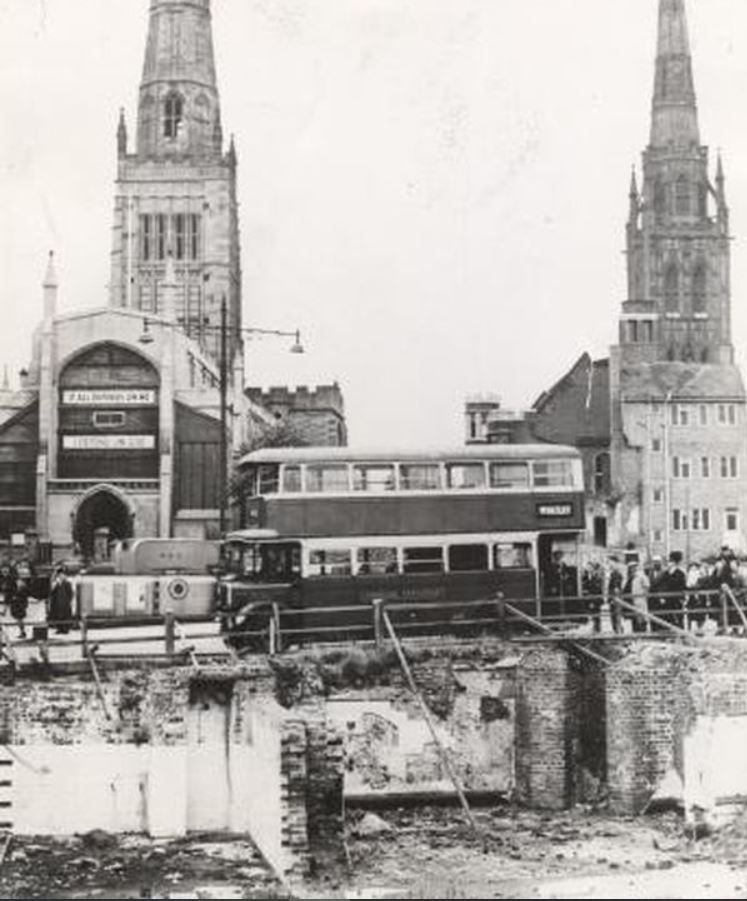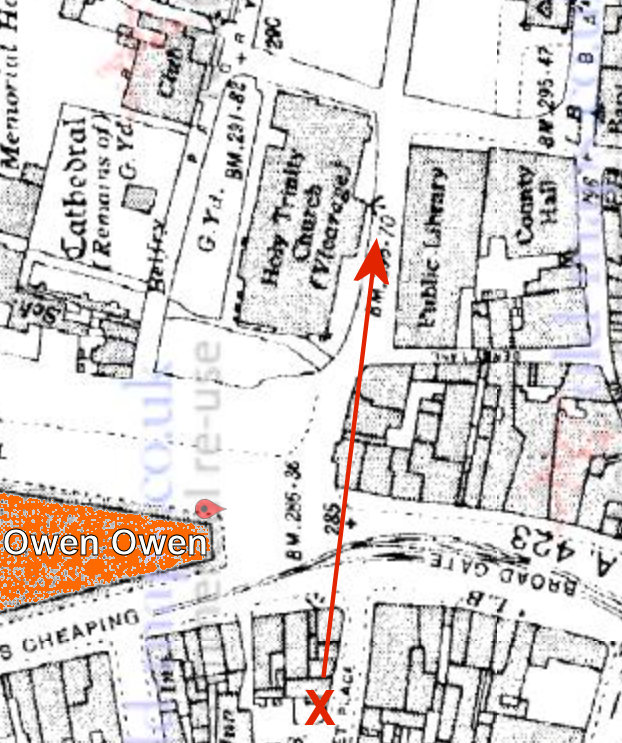Annewiggy
Tamworth
|
166 of 243
Fri 27th Aug 2021 2:04pm
The bus in photo was hired from London Transport. The picture also appears at a slightly different angle in Coventry Transport 1940-1974. It says it was ST 481(GK5312), an AEC Regent with LGOC body. For any one interested in buses. |
|
Wartime and the Blitz -
Bombing aftermath
|
Annewiggy
Tamworth
|
167 of 243
Tue 31st Aug 2021 12:33pm
I have just found Neil's picture on the London Transport site and it is dated 1940. Owen Owen would have still have had the shell of the building then. |
|
Wartime and the Blitz -
Bombing aftermath
|
Kaga simpson
Peacehaven, East Sussex
|
168 of 243
Tue 31st Aug 2021 1:11pm
Annewiggy,
Good morning. Wonderful, love your pictures and information, but I have to ask, on 16 Nov 1940, the King is seen walking in that very spot, rubble piled high, not a hole anywhere. It was a short time left to be in Cross Cheaping and as far as I recall was never cleared till much later?
What say the forum? |
|
Wartime and the Blitz -
Bombing aftermath
|
Kaga simpson
Peacehaven, East Sussex
|
169 of 243
Tue 31st Aug 2021 3:49pm
Annewiggy,
You have caught me out, there were no buses on that side level with Owen's in 1940. I sincerely apologise to everyone for the bad mistake I made, especially to Neil. I could have sworn it was Owen's basement. I still have a few doubts, but Annewiggy's date is against me.
I can only offer that age caught up with me.
|
|
Wartime and the Blitz -
Bombing aftermath
|
NeilsYard
Coventry
|
170 of 243
Tue 31st Aug 2021 4:01pm
Never any need to apologise to me, Kaga - we're grateful for all your insights on here  |
|
Wartime and the Blitz -
Bombing aftermath
|
Annewiggy
Tamworth
|
171 of 243
Tue 31st Aug 2021 5:10pm
I'll let you off this time Kaga, but it has given me more interesting things to look at. I was asking myself what happened to all the rubble. I found an article, that I can't find again, that none of the rubble was being wasted, metal and bricks were all being put to good use. Looking at the end of November 1940 and December articles show how quickly people were trying to get back to normal. There are several pictures showing the area of Broadgate next to Burton's with no rubble but they are not dated but cannot be long after the end of 1940 or into 1941. I think a lot of pictures were taken in the few days after the bombing which shows the city at its worst. |
|
Wartime and the Blitz -
Bombing aftermath
|
Rob Orland
Historic Coventry
|
172 of 243
Wed 1st Sep 2021 2:37pm
On 24th Aug 2021 4:53pm, NeilsYard said:
Old cellars on Broadgate revealed. Thanks to the London Transport site and Adrian James on FB.

As we can see, the photographer in Neil's photo above was looking directly up between Trinity Church and Gulson Library. So, working backwards, I believe the 1937 map snippet below shows the approximate location of the cameraman (X). The bomb damaged Owen Owen would've been out of shot to the left.

|
|
Wartime and the Blitz -
Bombing aftermath
|
matchle55
Coventry
|
173 of 243
Sun 14th Nov 2021 9:20am
My mother always reminded us of what happened on this date in 1940 - her family house in Queen Street, Coventry, was destroyed (they were sheltering nearby).
As her age increased, she was not sure if this was in April 1941 so although she is no longer with us it would be nice to have a definite answer.
Maybe someone could give a positive answer.
Thank you in anticipation.  |
|
Wartime and the Blitz -
Bombing aftermath
|
Helen F
Warrington
|
174 of 243
Sun 14th Nov 2021 11:27am
Was her home on this map? I don't know if this map includes both dates but it would be a start.
|
|
Wartime and the Blitz -
Bombing aftermath
|
Annie
Coventry
|
175 of 243
Sun 14th Nov 2021 1:21pm
Is there any truth in the story that after the bombings in the city centre, a building was so dangerous that the bodies of people in shelters under it who were killed were left there and the shelter concreted over, a plaque placed on site in memory?
|
|
Wartime and the Blitz -
Bombing aftermath
|
Annewiggy
Tamworth
|
176 of 243
Sun 14th Nov 2021 1:57pm
On 14th Nov 2021 9:20am, matchle55 said:
My mother always reminded us of what happened on this date in 1940 - her family house in Queen Street, Coventry, was destroyed (they were sheltering nearby).
As her age increased, she was not sure if this was in April 1941 so although she is no longer with us it would be nice to have a definite answer.
Maybe someone could give a positive answer.
Thank you in anticipation. 
Not a positive indication but may be a hint. In the CET 24th May 1941 there is an article about a man who was employed in moving salvaged material from Queen Street. Some lead was found on Hearsall Common, an observation was kept and he later returned to collect it. Would this indicate that the bombing would have been 1941?
|
|
Wartime and the Blitz -
Bombing aftermath
|
Wearethemods
Aberdeenshire
|
177 of 243
Sun 14th Nov 2021 8:16pm
I always remember a couple of stories that people were buried at the bottom of the 'slope' between Owens and the City Arms and also No.2 Gate at Armstrong Siddeley. Whilst they both had a 'direct hit', later excavations proved this was inaccurate. Likewise Gosford Green and Greyfriars Green. My mum was 'bombed out' twice, once at the top of Kirby Road, Earlsdon (Google Streetmaps show the new houses where, when I was a kid, wooden garages were in situ), later Turner Road or Sherlock Road, can't remember which, no doubt bombing records will show. Dad was away in the FLA. |
|
Wartime and the Blitz -
Bombing aftermath
|
Helen F
Warrington
|
178 of 243
Sun 14th Nov 2021 8:44pm
On 14th Nov 2021 1:21pm, Annie said:
Is there any truth in tbe story that after the bombings in the city centre, a building was so dangerous that the bodies of people in shelters under it who were killed were left there and the shelter concreted over, a plaque placed on site in memory?
I haven't heard of anything like that. It would probably have emerged as a problem at some modern point as a lot of the city centre has been excavated to well below old cellar levels. I'd have thought that the sort of building that would be considered too dangerous to demolish and excavate would be one working with poisons or something biological and while many factories had areas like that, I can't think of any that aren't now built on or still standing. I don't get the impression that the private cellars were very deep below ground level - the biggest and oldest originally had steps up to the street. Further out from the centre is more possible. Courtaulds had all sorts of tunnels and very weird places underneath, including a link from one side of the road to the other. Down one tunnel we discovered a well or something like one and had no idea how deep it was or what it had been for. There was no sign warning it was there. Parts of the site (and others) were very toxic. |
|
Wartime and the Blitz -
Bombing aftermath
|
matchle55
Coventry
|
179 of 243
Sun 14th Nov 2021 9:28pm
Helen,
I'm not sure as I cannot interpret the map accurately, but I think it might be.  |
|
Wartime and the Blitz -
Bombing aftermath
|
Kaga simpson
Peacehaven, East Sussex
|
180 of 243
Mon 15th Nov 2021 10:28am
I can't think that anyone was left under the rubble, the people just kept digging until they were certain there were no more bodies, but more to the point I never heard of any street shelter that did not collapse, or was not used. Goverment shelters (Anderson) were covered with dirt for easy access to trapped people. Council street shelters were covered with thick heavy concrete, that no one could move. A lot of people suffocated because air holes could not be punched in with all the concrete to get through. |
|
Wartime and the Blitz -
Bombing aftermath
|